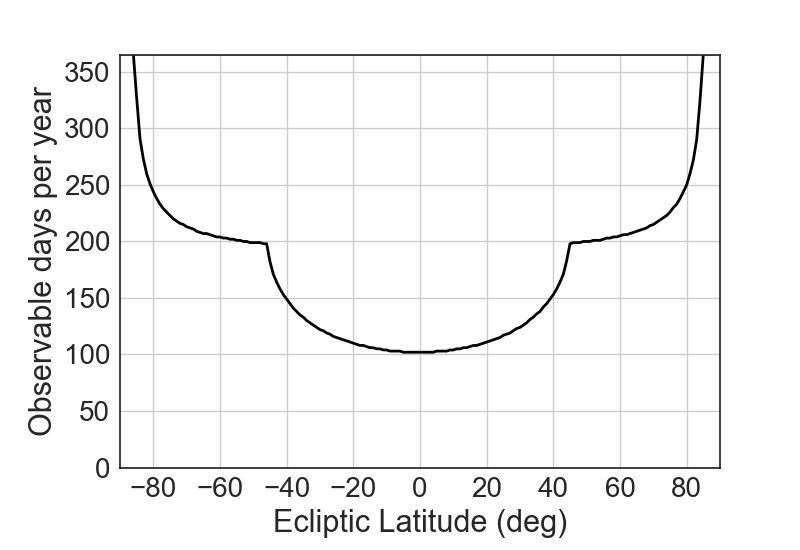JWST Background Variability
Backgrounds in JWST observations vary seasonally for a given sky position; the magnitude of that variation depends on the observation wavelength and ecliptic latitude.
On this page
See also: JWST Background-Limited Observations, JWST Backgrounds Tool
JWST observations include background emission from the zodiacal cloud, the Galaxy, and the observatory itself. A component of the background that varies seasonally is the zodiacal emission, due to the changing path length of Solar System dust through which JWST must look and the temperatures of that dust. This means that for a given fixed target, the JWST backgrounds will vary seasonally in a predictable way. The variation is most pronounced for wavelengths ~<15 μm, where zodiacal emission dominates the JWST background, and for targets at low ecliptic latitude (near the ecliptic plane). One consequence, as explained below, is that targets near the ecliptic plane may be observable with a low background for only a small fraction of their observable window. This can be a significant scheduling constraint for observations that are determined to be background limited.
JWST backgrounds vary seasonally for a given sky position. The magnitude of its variation depends on the observation's wavelength and the target's ecliptic latitude.
APT, the ETC, and the JWST scheduling system calculate these backgrounds, using the same background model. The JWST Backgrounds Tool can be used to calculate and visualize the seasonal variation of backgrounds for a given target.
Spatial and temporal variability of the background
Some components of the JWST background should be constant with time and telescope pointing, while others vary seasonally.
Thermal self-emission
Thermal self-emission dominates the JWST backgrounds for wavelengths > 12.5 μm. During commissioning, it was observed to be variable over ~week timescales by roughly 6% at F2550W, and less variable at shorter wavelengths.
Spatial variation of in-field emission
The in-field zodiacal emission depends strongly on ecliptic latitude. The in-field Galactic emission depends strongly on Galactic latitude.
Temporal variation of in-field emission
Words in bold are GUI menus/
panels or data software packages;
bold italics are buttons in GUI
tools or package parameters.
Spatial and temporal variation of stray light
Users should be aware that JWST is subject to stray light, and they should use the ETC to understand the degree to which stray light affects the signal-to-noise estimates for their planned observations.
The amount of stray light depends on the pointing and the observatory V3 roll angle. Models predict a strong correlation of the stray light level with the in-field zodiacal and Galactic background level, since half the susceptibility to stray light is predicted to occur within 35 degrees of the boresight (observatory V1 axis).
However, JWST is also susceptible to stray light from sources located far from the boresight. The JWST Exposure Time Calculator (ETC) uses maps that predict the susceptibility of JWST to stray light, given material properties and expected levels of dust contamination. For a given celestial position and date (which determines the nominal observatory V3 roll angle), the ETC projects the susceptibility maps onto the astronomical sky, to predict the amount of stray light at each instrument focal plane.
How seasonal variation of the background affects schedulability
The number of days per year that a target is observable to JWST is a simple function of ecliptic latitude, as illustrated by Figure 2. The JWST backgrounds are also a function of ecliptic latitude—both the minimum background over a year, and the shape of the seasonal variability curve. This has important consequences for target observability.
Advice for proposers
See also: JWST Background-Limited Observations
The JWST Background-Limited Observations article describes a simple method, using the JWST ETC, to determine whether the signal-to-noise ratio of a particular observation is sensitive to the time-variable background. Observations that are background sensitive should use the Background Limited special requirement in APT, so that the observation will be scheduled when the background is relatively low. This special requirement affects the schedulability of an observation.





